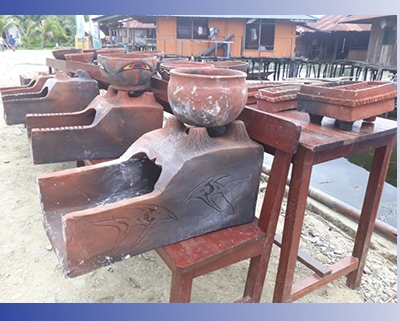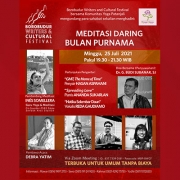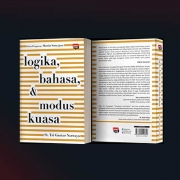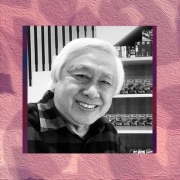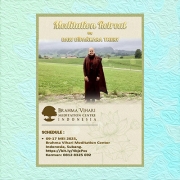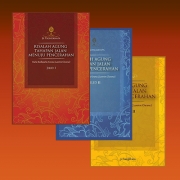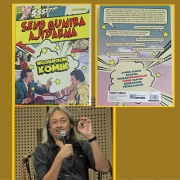Austronesian Culture in the Sentani Lake Area

by Hari Suroto
Foreword
Sentani is a lake located in north part of Papua which geographically lies 26.5 km from east to south, forming S letter, covering 9,635 hectare area and 0.75 – 6 km width. It is situated at an altitude of 75 meters above sea level, with 6 – 140 meter lake depth. There are 22 islands spreading across lake. There is range of hills on the south part of Sentani, while the Cyclops [Dobonsolo (local name)] Mountain Range lies on its north part and becomes a boarder with the Pacific Ocean.
Cyclops Mountain Range, which flows through River Koyabu, Hubai, Makaole, Klebouw, Taban, Klandili, and Abeale, becomes the water source in Sentani Lake. Sentani tribe uses those rivers for fishing, water source, and finding kind of stones to make stone axe (tomako batu).
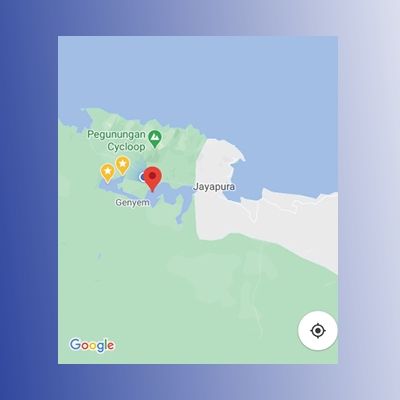
The Lake Sentani map. (Source: Google Maps)
Jaifuri River that is located on the east part of the lake, empties into the Pacific Ocean bordered on Papua New Guinea. It connects the inhabitants in Sentani with those who inhabit the Pacific Ocean coastal area. They use large boat (kayi/female boat) and small boat (ifa/male boat) as their means of transportation.
Sentani people live in groups both in the lake-bed and islands in Sentani. There are hamlets in Sentani, namely; Yoka, Waena, Sebeaiburu, Puay, Ayapo, Big Asei and Small Asei, Netar, Big Ifar, Small Ifar (Ifale), Hobong, Yobhe, Yabuai, Putali, Abar, Atamali, Yoboi, Simporo, Babrongko, Dondai, Kwadeware, Yakonde, Sosiri, and Doyo.
House in Sentani is made in stage house construction with its front part on the land while its back above the water. The house is supported by soang wood pile (Xanthostemon sp.) embedded in the lake base, having sago midrib for the wall and sago stem for the floor.
At 1500 to 1000 BC, the Austronesian speakers came (Suroto, 2010:55). They have possessed developed culture and technology. They have known domestication of chicken, dog, and pig. They also produced a complex set of shell ornaments and implements, including fishhooks, armbands, and trumpets. There is a structure of social organization in hierarchy system, in which the leader is chosen from generation to generation (Muller, 2008:53). Chewing areaca nut and having tattoo are the characteristics of Austronesian culture (Bellwood, 2000:199). The Austronesian speakers also carry a culture in making stage house (Soejono, 1998:11), and alcoholic drink made from palm sugar (Sacerifera), coconut (Cocos nucifera) (Suroto, 2010:55).
The early Austronesian speakers have made pottery and raised pig, dog, and chicken. Such elements are widely found and begun in Indonesian Archipelago around 4000 years ago. It is the evidence to show the presence of Austronesian speakers, however it is too soon to draw conclusion and reveal the existence of Austronesian speakers in Papua (Bellwood, 2000:169). Based on the distribution of pottery artefact and language, the Austronesian speakers mostly inhabit, do activities, and interact with the indigenous Papua in the coastal area (Suroto, 2010:43).
Based on the above description, the Austronesian’s culture influences mostly the north coastal area of Papua. Lake Sentani is located in the north part of Papua and the language used belongs to non-Austronesian (Trans New Guinea phylum). It is such an interesting point whether the Austronesian’s culture is found in Sentani Lake area. This study would like to reveal the influence of Austronesian culture in Sentani Lake Area. The data gathering method used is surface survey, excavation, and ethnoarchaeologycal approach with descriptive-qualitative method.
Discussion
The presence of Austronesian culture in Sentani begins with the result of archaeological research in that area which shows pottery artefacts are found in archaeological open sites and caves, either on the surface or inside the earth. The open sites contributing pottery are Yomokho, Kwadeware, Abar, Phulende and Mantai. While the caves are Cave Rukhabulu Cave Awabhu, Reugable rock shelter, and Ifeli-feli rock shelter. The context of such pottery are freshwater snail shell (Thiaridae) and sea mollusc shell from bivalvia class, veneridae family.
Yomokho Site as a place for human activity is dated 2590 ± 120 BP. An open settlement having stage houses on the hill’s slope. Settlement on hill is considered more strategic and safe as it is spared from malaria attack. The result of excavation in Yomokho Site shows that potteries are used as a place for cooking, keeping food and burial gift. The designs of such pottery are zigzag, wavy, ditted, and diagonal with red slip. Based on the dating, human activity at Yomokho Site is proper with the arrival of Austronesia in West Pacific around 3000 years ago.
The finding of sea mollusc bracelet at Ifeli-feli rock shelter in Babrongko is similar to that of shells in Tongatapu Site in Tonga and Samoan Island in Melanesia. According to Bellwood (1978:534), the finding in Tongatapu is dated 1300 BC, while for Samoan Island is dated 1000 BC.
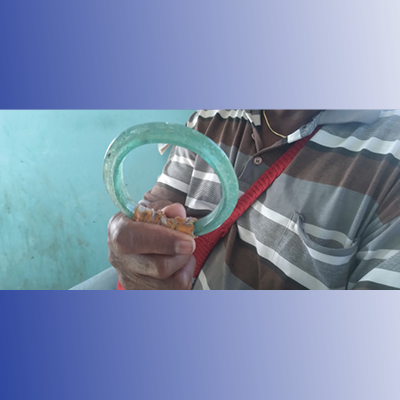
Glass bracelet in Doyo Lama Village. (Photo: Hari Suroto)
The decoration pattern from Kwadeware Site possesses similarity to pottery from Skouw Mabo Cave Jayapura, Lachitu and Taora Cave in Papua New Guinea. Gorecki (1992:35) stated that the potteries from Lachitu and Taora are dated 5400 years ago, however, some researchers doubted it and believed that it should be younger (Simanjuntak, 1997:944).
Cooking with pottery is not well-known in Papua area in which the inhabitants speak non-Austronesia language, except for Sentani. Pottery becomes important for Sentani tribe that lives from sago processing (Metroxylon sago) and consuming fish and freshwater molluscs. The only place that produces pottery in Sentani Lake area is Abar. The Abar’s potteries are made from the mixture of clay and sand. It uses the combination of hand made and paddle-anvil technique. It is decorated by appliqué, impressed and stamped techniques. The Pottery is burnt in an open area so that it will produce uneven red or brown colours. The potteries, then, are used as a means of barter by exchanging it with beads, stone axe, and food source.
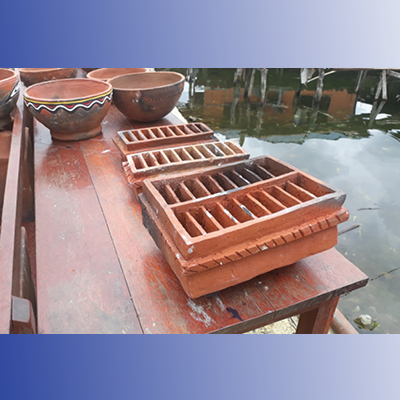
The Abar’s potteries (1). (Photo: Hari Suroto)
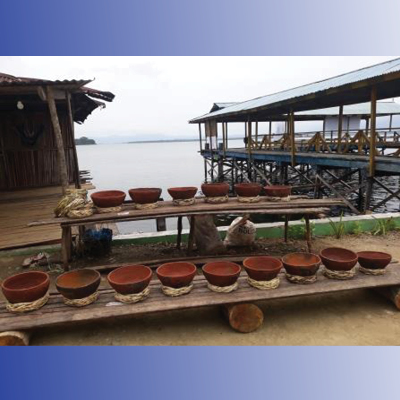
The Abar’s potteries (2). (Photo: Hari Suroto)
A big-sized jar is known as hele in Sentani language. It has 50 cm height, 30 cm diameter, and 0.7 cm thickness. The jar is used as a place to keep water and sago powder. Helai, the small jar, is used for cooking, boiling water, and processing sago porridge (papeda), keeping fish and meat. Olomebe is a particular jar for cooking fish (black snake-head fish [kayaou (local name), Oxyeleotoris herwedinii], gete-gete [kahe (local name), Apogon wichmani], puri danau [hew (local name), Chilaterina sentaniensis], eel [kahilo (local name), Aguilla bicolor)], Sembilan fish [kanseli (local name), Arius veluntinus)] and fresh water snail (Thiara scabra, Melanoides tuberkulata, Melanoides canalis, Stelomelania sp., Melanoides granifera, Melanoides copalis, dan Malanoides sentaniensi). Kende is a kind of oval plate made from clay. Kende is used to serve cooked meat and fish.
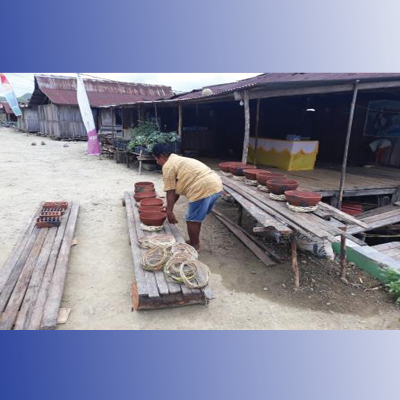
The Abar’s potteries (3). (Photo: Hari Suroto)
The Sentani tribe knows tattoo for their face, arms, and legs. Tattoo symbolizes power, beauty, and social status. Therefore, the variation of tattoo depends on the social status (ondofolo/the highest leader, kotelo/tribal chief, and yobu yoholom/ common people) and gender. Tatoo is made by using thorn of sago or hard-shelled tubers. The thorn is dipped into a mixture of sap and charcoal, then is pricked on the body. Male will have simpler design on their nose and forehead, while female have the more complex pattern on their nose, backs, arms, and calves. The tattoo is generally designed like fractions of ornament, animals, and symbols. It depends on the body area, for example; a tattoo on the nose will suit the nose itself (Yektiningtyas-Modouw, 2008:63).
Sentani people also know the making of saguer, a traditional alcoholic drink from coconut sap. Saguer is a white liquid that tastes sour-sweet and contains around 5% of alcohol. Such drink can be made by having a bamboo container, with palm fibre filters, hung on coconut flower stem which has been cut.
There is also chewing leaf betel tradition (Areca catechu), that is combined with betel nut (piper betle), and powder from freshwater mollusc shells (Bivalvia Class Veneridae Family, [kheka (local name)]. The greyish-white powder is more preferred as it gives less strong burning sensation. However, the bright white powder will give stronger burning sensation in the mouth. Areca nut symbolizes respect and a means of good relation for Sentani tribe.
Sea mollusc shell is gained from the Pacific Ocean. The kheka mollusc shells are collected from the lake. Powder is made by arranging dry sago leaves in a layer on the earth surface. The shells are put on such layer. Then, layer of dry sago leaf is put on the shell. The number of leaf is suited with the number of mollusc shells that will be burnt. That pile of leaves and shells is tied and burnt from the earth surface. After that, hot shells are gathered in a container and poured by water. It will be smashed itself becoming powder. Such powder is filtering and ready to use. Traditionally, the powder is kept in a dry decorated-coconut shell.
Sentani tribe knows ondoafi leadership system, that means a structured social organization in which the leader is chosen from generation to generation. The leader is held by the firstborn child of the former leader, coming from the most senior clan (the ancestor of the founder).
Pig (Sus Scrofa Papuensis) is raised and worth for Sentani people. They only have around three or four pigs freed around the house. The pig is fed with tuber leaves, leafy vegetable, coconut, and sago stem. Pork meat is served as the main course in a party and various Sentani traditional rituals. For Sentani people, a tribal chief deserves to share the sliced meat in a particular event.
The Austronesia speakers who migrate to Pacific adapt the surrounding environment, leaving rice cultivation, consuming local plants (breadfruit (Artocarpus altilis), caladium (Colocasia esculenta), banana (Australimusa), coconut, cane (Saccharum Officinarum L., Saccharum Spotaneum L., Saccharum Robustus Brandes Jeswiet) and sago), looking for sea products and exchanging with the local people. The barter commodities are exotic stuffs like bronze artifacts, beads, and glass bracelets those are exchanged with the exotic cenderawasih (Paradisaea minor) (Suroto, 2010:56).
Bronze artefacts, glass beads, and glass bracelet are found in Sentani Lake area either in the archaeological site or kept by the people. Thus far, those stuffs become valuable and prestigious for Sentani tribe as roboni (dowry).
White-glassed beads artefacts are found in the excavation in Yomokho Site. While the black-glassed beads are found in Phulende. Bronze artefact that has just found in Kwadeware is an axe with convex shape and widen on its sharp edge (Tim peneliti, 2010:18). On one of the axe’s level side, there is spiral decoration encircling a salient point as the centre of area. Such axe is kept by Timotius Marweri (Ondofolo Kwadeware) and is getting worn-out. The decoration is fading away. Seen from its motif, this axe is made not for practical usage but for religious or social purposes. For Kwadeware people, this axe is one of dowries for ondofolo Marweri family.
Sentani’s folklore states that their ancestor are from East Sepik, Papua New Guinea to the west, arriving and settling in Sentani Lake. It is appropriate with the story of the glass bracelet and beads owner that those kind of artefacts are brought by their ancestor when they came from east to west. It is estimated that the glass artefacts come from the east since Vanimo and Aitape, Papua New Guinea are also familiar with the culture of using such artefacts.
The obviously different thing is Vanimo’s folklore that mentions their ancestor comes from Sentani Lake area. Based on those two versions, it can be described that Vanimo and Sentani people posses historical relationship. It is proved not only by the existence of glass bracelet and beads artefacts but also the remaining foodstuff like sea mollusc shells in the archaeological sites in Sentani Lake area, and the existence of mollusc shells as the main material in making powder as well. Those are the evidences that Sentani people make relationship with those who live near the Papua New Guinea coast (Vanimo, Aitape, east Sepik).
The origin of Austronesian culture in Sentani Lake area is an interesting point to study. Did Sentani people make a direct relation with the Austronesian speakers? Based on the linguistic evidence that Sentani language is considered as non-Austronesia, it is estimated that Sentani people did not have direct relation with the Austronesia speakers, but indirectly through the peole in Vanimo, Aitape, and East Sepik.
Closing
The influence of Austronesian culture in Sentani Lake area, based on the archaeological and ethnoarchaeological researches, are pottery artefact, glass bracelet, glass beads, bronze artefact, pottery making tradition, tattoo tradition, alcoholic-drink making from coconut trees, hierarchy leadership system, and animal rasing (pig, dog, and chicken). The arrival of Austronesian culture in Sentani Lake area is not from the direct contact between those two communities but from the indirect contact through the coastal communities living in Vanimo, Aitape, and East Sepik Papua New Guinea.
———–
*Hari Suroto is a researcher at the Papua Archeology Center
———–
Reference
Bellwood, Peter. 1978. Man’s Conquest of The Paciific The Prehistory of Southeast Asia and Oceania. Aucland: Collins.
Bellwood, Peter. 2000. Prasejarah Kepulauan Indo-Malaysia. Jakarta: PT Gramedia Pustaka Utama.
Gorecki, P. 1992. “A Lapita smoke screen?”, Actes du Colloque Lapita. ORSTOM: Noumea.p. 27-47.
Muller, Kal. 2008. Introducing Papua. Daisy World Books.
Simanjuntak, Harry Truman. 1997. “Revieuw of the prehistory of Irian Jaya” dalam Jelle Miedema, Cecilia Ode dan Rien A.C. Dam (ed.), Perspectives on the Bird’s Head of Irian Jaya, Indonesia. Proceedings of the Conference Leiden, 13-17 October 1997. p. 941-950.
Soejono, R.P. 1998. ”Indonesia dalam lingkup Prasejarah Asia Tenggara dan Pasifik” dalam Dinamika Budaya Asia Tenggara-Pasifik dalam Perjalanan Sejarah. DIA X Bandung 1997. IAAI komda Jawa Barat. p. 9-12.
Suroto, Hari. 2010. Prasejarah Papua. Denpasar: Udayana Universiy Press.
Tim Penelitian. 2010. Penelitian Arkeologi di Kawasan Danau Sentani. Laporan Penelitian Balai Arkeologi Jayapura.
Yektiningtyas-Modouw, Wigati. 2008. Helaehili dan Ehabla. Fungsinya dan Peran Perempuan dalam Masyarakat Sentani Papua. Yogyakarta: Adicitra Karya Nusa.


